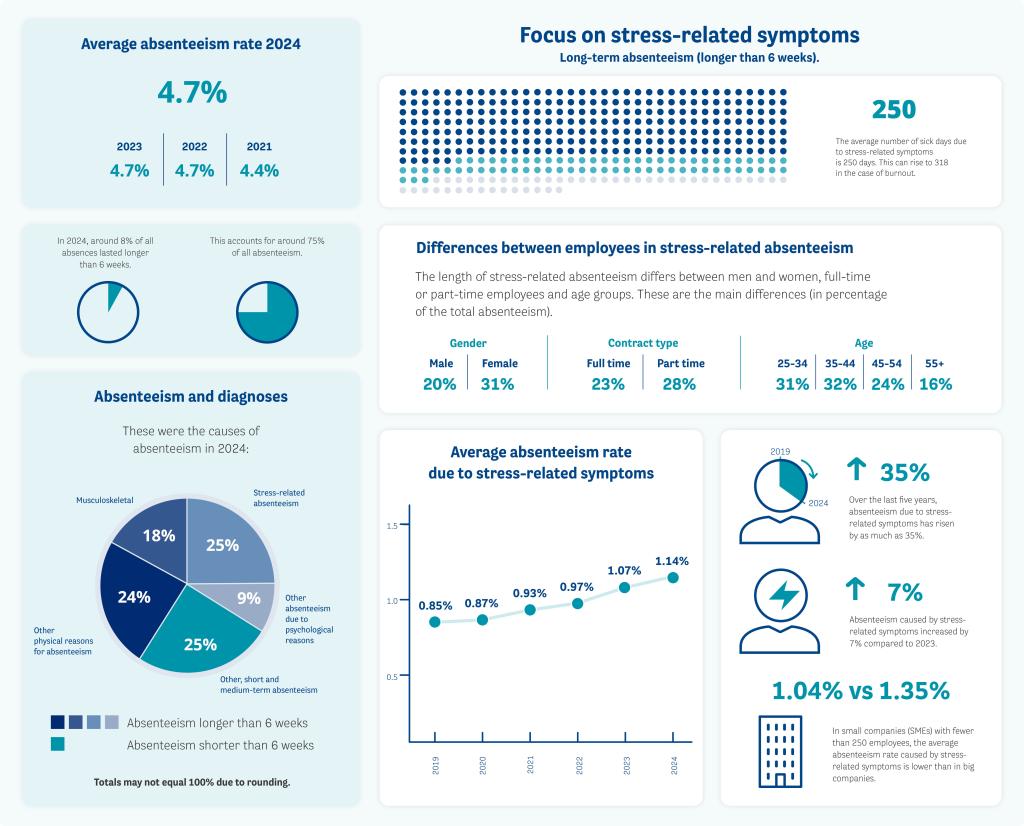Rising stress-related absenteeism is a growing problem for the working population in the Netherlands

Stress-related absenteeism is rising
In 2024, the average absenteeism rate was 4.7%, nearly the same level as the previous year. Although the total absenteeism rate remained stable, the occupational health and safety services indicate that rising stress-related absenteeism is a growing problem for the working population in the Netherlands. Around one in four sick days is caused by stress. Furthermore, the length of stress-related absenteeism is increasing every year. In 2024, this meant that employees were out of the running for an average 250 days. In the case of burnout, this could be as much as ten months; 318 days to be exact.
Differences between employees and organisation
ArboNed and HumanCapitalCare have established that stress-related absenteeism differs considerably between age groups, business sectors and organisations of different sizes.
- Among employees between the ages of 25 and 45, in particular, the reason for absenteeism is often stress-related.
- Relatively more stress-related absenteeism is recorded for women than for men.
- Among part-time employees, absenteeism is more often related to stress than among full-time workers.
- Absenteeism due to stress-related symptoms is highest in public administration, healthcare and education.
In companies with more than 250 employees, stress-related absenteeism is higher than in smaller companies (SMEs).
Recognise the signs
Stress can be caused by work, home life or societal changes. The causes may differ but the signs are often the same: worrying, listlessness and tension. These three signs are key predictors of absenteeism, according to the survey. “Often it is easier to recognise these signs in others than in yourself,” says Redmer van Wijngaarden, occupational physician and medical director at ArboNed. “If employers and colleagues recognise these signs in someone else, it is crucial to be able to discuss them. That’s hard, which is why it doesn’t always happen. But this is the only way that employers and employees can look for solutions together at an early stage and prevent symptoms becoming worse. Early intervention, such as an open consultation hour with the occupational physician or rapid access to a company psychologist, improves employee welfare and helps shorten or prevent absenteeism.”
Support from the employer
Van Wijngaarden: “Although it is not always possible to influence external factors, the way in which employees cope with stress, the available energy resources and the support they are given play a crucial role in preventing absenteeism. Even when stress is caused by situations at home - such as divorce, bereavement or informal caregiving - employers can offer support. This might be in the form of flexible working and, where necessary, by facilitating professional help. In addition, tools like the Risk Inventory and Evaluation (RI&E) and the Preventive Medical Examination (PME) help the employer identify risk factors at an early stage and take preventive action.
Flu-related absenteeism on the rise
Besides long-term absenteeism caused by stress, flu symptoms also cause temporary peaks in short-term absenteeism every year. The average absenteeism rate rose to 5.4% in February 2025 (compared with 5.1% in January). Absenteeism in February was thus considerably higher than in February 2024 (5.1%). Absenteeism caused by flu symptoms is now declining, so the peak is now behind us.